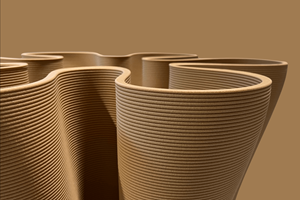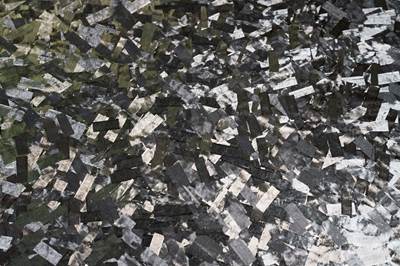Ultra-light woven reinforcement fabrics enhance space-grade parts
CAMX 2024: TeXtreme is showcasing its TeXtreme 0/90 woven fabrics, demonstrated through customer Kerberos Engineering’s satellite solar array.
Share
TeXtreme 0/90 woven material. Source (All Images) | TeXtreme
(Boras, Sweden) is displaying its ultra-light reinforcement fabrics that are designed to help composites manufacturers save weight and resources while maintaining the durability and enhancing the structural integrity of the part produced. Products reinforced with TeXtreme are said to be 20–30% lighter than those using conventional carbon fiber reinforcements. The company is showcasing these products, as well as the Kerberos Engineering (Padova, Italy) satellite solar array.
Kerberos Engineering, a company developing space-grade composite satellite subsystem structures, is a customer of TeXtreme. The company’s area of expertise lies in deployable satellite solar array structures, for which it has integrated TeXtreme 0/90 woven spread tow fabrics. It is said that this strategic selection of materials has led to a 90% reduction in resources required for manufacturing the solar arrays compared to conventional techniques. The company says that the most notable benefit the material has is its reduction in labor requirements. Meanwhile, traditional unidirectional (UD) prepreg materials necessitate a labor-intensive layer-by-layer application; each layer must be precisely aligned and carefully handled to avoid fraying and separation, which can lead to extended production times and increased labor costs.
Kerberos satellite solar array.
TeXtreme 0/90 simplifies the manufacturing process with its woven structure and compatibility with vacuum-assisted resin transfer molding (VARTM). The technique enables the rapid and uniform infusion of resin, which reduces the overall labor input and expedite production. With TeXtreme 0/90, the streamlined VARTM process can minimize handling complexity and reduce the need for multiple curing stages.
Material efficiency is also said to be provided by TeXtreme 0/90, as the woven fabric can minimize issues such as fraying and fiber separation, common in UD prepregs, leading to material waste. TeXtreme’s 0/90 configuration is capable of providing structural integrity and reducing the need for excessive layering to achieve desired properties. By using fewer layers and optimizing material use, TeXtreme 0/90 is designed to meet the performance requirements of space environments and reduces material waste, which can lower production costs and environmental impact.
Related Content
-
Sulapac introduces Sulapac Flow 1.7 to replace PLA, ABS and PP in FDM, FGF
Available as filament and granules for extrusion, new wood composite matches properties yet is compostable, eliminates microplastics and reduces carbon footprint.
-
Development of a composite liquid hydrogen tank for commercial aircraft
Netherlands consortium advances cryogenic composites testing, tank designs and manufacturing including AFP, hybrid winding, welding of tank components and integrated SHM and H2 sensors for demonstrators in 2025.
-
Combining multifunctional thermoplastic composites, additive manufacturing for next-gen airframe structures
The DOMMINIO project combines AFP with 3D printed gyroid cores, embedded SHM sensors and smart materials for induction-driven disassembly of parts at end of life.
Related Content
Sulapac introduces Sulapac Flow 1.7 to replace PLA, ABS and PP in FDM, FGF
Available as filament and granules for extrusion, new wood composite matches properties yet is compostable, eliminates microplastics and reduces carbon footprint.
Read MoreDevelopment of a composite liquid hydrogen tank for commercial aircraft
Netherlands consortium advances cryogenic composites testing, tank designs and manufacturing including AFP, hybrid winding, welding of tank components and integrated SHM and H2 sensors for demonstrators in 2025.
Read MoreCombining multifunctional thermoplastic composites, additive manufacturing for next-gen airframe structures
The DOMMINIO project combines AFP with 3D printed gyroid cores, embedded SHM sensors and smart materials for induction-driven disassembly of parts at end of life.
Read MorePlant tour: Airbus, Illescas, Spain
Airbus’ Illescas facility, featuring highly automated composites processes for the A350 lower wing cover and one-piece Section 19 fuselage barrels, works toward production ramp-ups and next-generation aircraft.
Read MoreRead Next
TeXtreme releases TeXtreme 360° discontinuous tape-based fiber
High strength, stiffness and fatigue performance, in addition to enhanced design flexibility, make the spread tow tapes well suited for application versatility.
Read MoreFaction Skis feature TeXtreme spread tow fabrics
Each Prime 4.0 ski from Faction Skis weighs just 1740g and is optimized for high-performance, technical skiing.
Read MoreCeramic matrix composites: Faster, cheaper, higher temperature
New players proliferate, increasing CMC materials and manufacturing capacity, novel processes and automation to meet demand for higher part volumes and performance.
Read More






